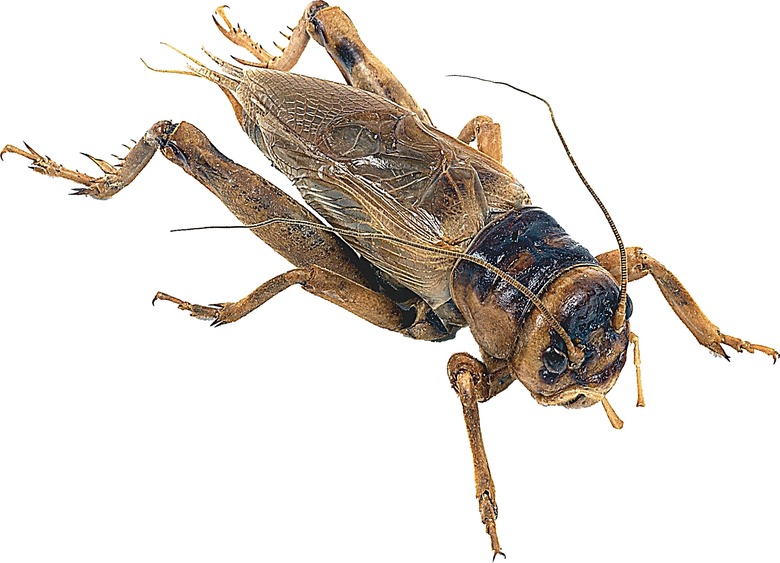Differences Between Crickets & Cockroaches
When a small, brown-colored insect scutters around the dark corner of your closet or flees when you're moving old boxes, you might wonder – was that a cricket or cockroach? Though they have a few distinct differences, crickets and cockroaches look relatively similar. They're around the same size and both come in varying shades of brown and black. So how do you tell the difference between a cricket and a roach?
Keys to Cockroach or Cricket Identification
Keys to Cockroach or Cricket Identification
Crickets and cockroaches have several distinct characteristics that you can use to distinguish between them. The first major difference between the two is their body shape and their general anatomy. The second primary way to differentiate between crickets and cockroaches is to listen closely for their sounds (or lack thereof).
Cricket vs. Cockroach: Taxonomy
Cricket vs. Cockroach: Taxonomy
Though roaches and crickets might look similar, they're actually quite different and not closely related. Though researchers consider both 'true insects' and place them in the class Insecta, that's where the relation between the two ends!
Scientists classify crickets in the order Orthoptera, alongside grasshoppers, locusts and katydids. The creatures in Orthoptera are best known for their ability to jump using their long hind legs. Conversely, researchers classify cockroaches into the Blattodea order. The only other members of Blattodea are termites. Scientists estimate that approximately 4,500 species of cockroaches exist, but only 30 or so inhabit human dwellings.
Cricket vs. Cockroach: Body Shape
Cricket vs. Cockroach: Body Shape
With a bit of practice, you should be able to identify crickets and cockroaches at a glance just by looking at their body shape. Cockroaches have a flattened, oval body shape that is low to the ground. Crickets, on the other hand, have an elongated body shape that looks more cylindrical.
If you're still in doubt, take a closer look at the legs. Cockroaches have legs that measure around the same length, and they're typically hidden or partially hidden beneath their bodies. You can easily spot a cricket's legs and see where they attach to its body. Additionally, crickets have elongated rear legs (much like grasshoppers) which they use to jump away from danger.
Which Has Wings, Cricket or Cockroach?
Which Has Wings, Cricket or Cockroach?
Another easily visible way to distinguish between crickets and cockroaches is by looking for wings. Granted, both creatures have wings and can fly; however, both also rarely use their wings, preferring to run or hop along the ground. But when asking yourself 'cricket vs. roach?' you can use those wings to help you tell the difference.
If you look closely at a cricket, you will notice that they have visible wings on top of their thorax, or midsection. You can easily tell their relatively short wings apart from the rest of their body. Cockroaches have wings, but their wings fold uniformly over their entire body, which gives the appearance that the wings are actually the 'body' of the cockroach.
Cricket vs. Roach: Sounds
Cricket vs. Roach: Sounds
Though you can't actually see this feature, sound is a telltale indicator of the difference between crickets and cockroaches. Generally, cockroaches make little to no sound while inside your home, with the exception of the occasional quiet skittering noise of their legs tapping across a hard surface. Sure, some cockroach species produce noises, such as hissing cockroaches, but those generally do not live within homes.
Unlike cockroaches, crickets are renowned for their ability to make characteristic sounds. These insects produce a chirping noise to attract their mate, sound an alarm and even while fighting with other crickets. Despite the popular myth, crickets do not use their legs to produce sound, but their wings! Male crickets have specialized scrapers on their wings which they rub together to produce their characteristic chirp.
You can listen in on the common house cricket's chirp on the Orkin website (see Resources section).
Cite This Article
MLA
Zinni, Yasmin. "Differences Between Crickets & Cockroaches" sciencing.com, https://www.sciencing.com/differences-between-crickets-cockroaches-12570862/. 30 September 2021.
APA
Zinni, Yasmin. (2021, September 30). Differences Between Crickets & Cockroaches. sciencing.com. Retrieved from https://www.sciencing.com/differences-between-crickets-cockroaches-12570862/
Chicago
Zinni, Yasmin. Differences Between Crickets & Cockroaches last modified March 24, 2022. https://www.sciencing.com/differences-between-crickets-cockroaches-12570862/
